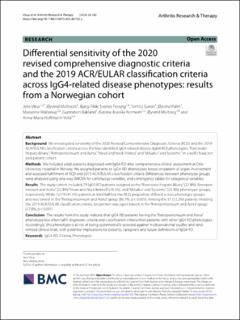| dc.contributor.author | Vikse, Jens | |
| dc.contributor.author | Midtvedt, Øyvind | |
| dc.contributor.author | Fevang, Bjørg Tilde Svanes | |
| dc.contributor.author | Garen, Torhild Oddveig | |
| dc.contributor.author | Palm, Øyvind | |
| dc.contributor.author | Wallenius, Marianne | |
| dc.contributor.author | Bakland, Gunnstein | |
| dc.contributor.author | Norheim, Katrine Brække | |
| dc.contributor.author | Molberg, Øyvind | |
| dc.contributor.author | Hoffmann-Vold, Anna-Maria | |
| dc.date.accessioned | 2023-11-16T06:44:53Z | |
| dc.date.available | 2023-11-16T06:44:53Z | |
| dc.date.created | 2023-09-14T14:53:07Z | |
| dc.date.issued | 2023 | |
| dc.identifier.issn | 1478-6354 | |
| dc.identifier.uri | https://hdl.handle.net/11250/3102855 | |
| dc.description.abstract | Background
We investigated sensitivity of the 2020 Revised Comprehensive Diagnostic Criteria (RCD) and the 2019 ACR/EULAR classification criteria across the four identified IgG4-related disease (IgG4-RD) phenotypes: “Pancreato-Hepato-Biliary”, “Retroperitoneum and Aorta”, “Head and Neck-limited” and “Mikulicz’ and Systemic” in a well-characterized patient cohort.
Methods
We included adult patients diagnosed with IgG4-RD after comprehensive clinical assessment at Oslo University Hospital in Norway. We assigned patients to IgG4-RD phenotypes based on pattern of organ involvement and assessed fulfillment of RCD and 2019 ACR/EULAR classification criteria. Differences between phenotype groups were analyzed using one-way ANOVA for continuous variables, and contingency tables for categorical variables.
Results
The study cohort included 79 IgG4-RD patients assigned to the “Pancreato-Hepato-Biliary” (22.8%), Retroperitoneum and Aorta” (22.8%) “Head and Neck-limited” (29.1%), and “Mikulicz’ and Systemic” (25.3%) phenotype groups, respectively. While 72/79 (91.1%) patients in total fulfilled the RCD, proportion differed across phenotype groups and was lowest in the “Retroperitoneum and Aorta” group (66.7%, p < 0.001). Among the 57 (72.2%) patients meeting the 2019 ACR/EULAR classification criteria, proportion was again lowest in the “Retroperitoneum and Aorta” group (27.8%, p < 0.001).
Conclusion
The results from this study indicate that IgG4-RD patients having the “Retroperitoneum and Aorta” phenotype less often fulfill diagnostic criteria and classification criteria than patients with other IgG4-RD phenotypes. Accordingly, this phenotype is at risk of being systematically selected against in observational studies and randomized clinical trials, with potential implications for patients, caregivers and future definitions of IgG4-RD. | en_US |
| dc.language.iso | eng | en_US |
| dc.publisher | BioMed Central Ltd. | en_US |
| dc.rights | Navngivelse 4.0 Internasjonal | * |
| dc.rights.uri | http://creativecommons.org/licenses/by/4.0/deed.no | * |
| dc.title | Differential sensitivity of the 2020 revised comprehensive diagnostic criteria and the 2019 ACR/EULAR classification criteria across IgG4-related disease phenotypes: results from a Norwegian cohort | en_US |
| dc.title.alternative | Differential sensitivity of the 2020 revised comprehensive diagnostic criteria and the 2019 ACR/EULAR classification criteria across IgG4-related disease phenotypes: results from a Norwegian cohort | en_US |
| dc.type | Peer reviewed | en_US |
| dc.type | Journal article | en_US |
| dc.description.version | publishedVersion | en_US |
| dc.source.volume | 25 | en_US |
| dc.source.journal | Arthritis Research & Therapy | en_US |
| dc.identifier.doi | 10.1186/s13075-023-03155-y | |
| dc.identifier.cristin | 2175185 | |
| dc.source.articlenumber | 163 | en_US |
| cristin.ispublished | true | |
| cristin.fulltext | original | |
| cristin.qualitycode | 2 | |

